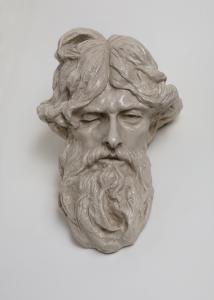James Vibert (1872-1942)
The Swiss sculptor James Vibert was born in Carouge in 1872. He began his training in Geneva at the School of Industrial Arts and then continued his studies in Lyon with an art ironworker. From 1892 to 1902, he lived in Paris. These were important years for him, during which he was an active participant in the most contemporary trends in international art. He frequented Parisian symbolist circles, sharing their goal of breaking down the barriers among the arts and their interests in dream and dark visions. He showed at the Salon de la Rose-Croix (The Rosicrucian Salon) and was friends with Ferdinand Hodler (1853-1918), Auguste de Niederhausern, known as “Rodo” (1863-1913), as well as with Paul Verlaine (1844-1896), Jean Moréas (1856-1910), and Gustave Kahn (1859-1936).
In 1895, Vibert did a portrait of Puvis de Chavannes (1824-1913) on a medal, and he worked alongside the sculptor Pompon (1855-1933) in the studio of Auguste Rodin (1840-1917) in 1894, while the latter was working on his Balzac. Like Rodin, Vibert was interested in the expressive possibilities of ceramics. Technical advances in the field of enameled stoneware dovetailed with a growing interest in the decorative arts, encouraging many sculptors to explore the medium. Vibert created a number of ceramic works in collaboration with the Émile Muller company and showed a group of them at the 1900 Universal Exhibition beside his sculpture Vita in Morte (Life in Death).
James Vibert returned to Switzerland in 1902 and the following year was asked to succeed Hugues Bovy (1841-1903) as professor at the École des Beaux-Arts in Geneva, where he remained until 1935. But he maintained his contacts with France; he was a founding member of the Salon d’Automne and showed there regularly from 1903 on. That same year he presented the group L’Effort Humain (Human Effort) in plaster, which was bought by the French state for 600 francs. Originally titled Autel à la Nature (Altar to Nature), it was an ambitious project that included most of Vibert’s works around the turn of the century. The first model for it was shown at the 1897 Salon des Cents in Paris. In Switzerland, Vibert worked on commissioned monuments and large public projects involving architectural decoration. He also collaborated with the architects Bruno Schmitz (1858-1916), Oskar Kaufman (1873-1956), and Joseph Hofman (1870-1956). Vibert began to simplify his sculptures’ volumes. His Monument to Paul Verlaine (a bust in stone) at Metz and the Monument des Communes Réunies (Monument to the Reunited Communes) at Carouge, his native city, were both inaugurated in 1925. Vibert pursued a parallel career as an administrator at the heart of the International Committee of the Red Cross from 1914 to 1927 and of the Swiss Society of the Fine Arts. Vibert died in April 1942 at Plan-les-Ouates.
Photograph: James Vibert sculpting the bust of Hodler 1918

